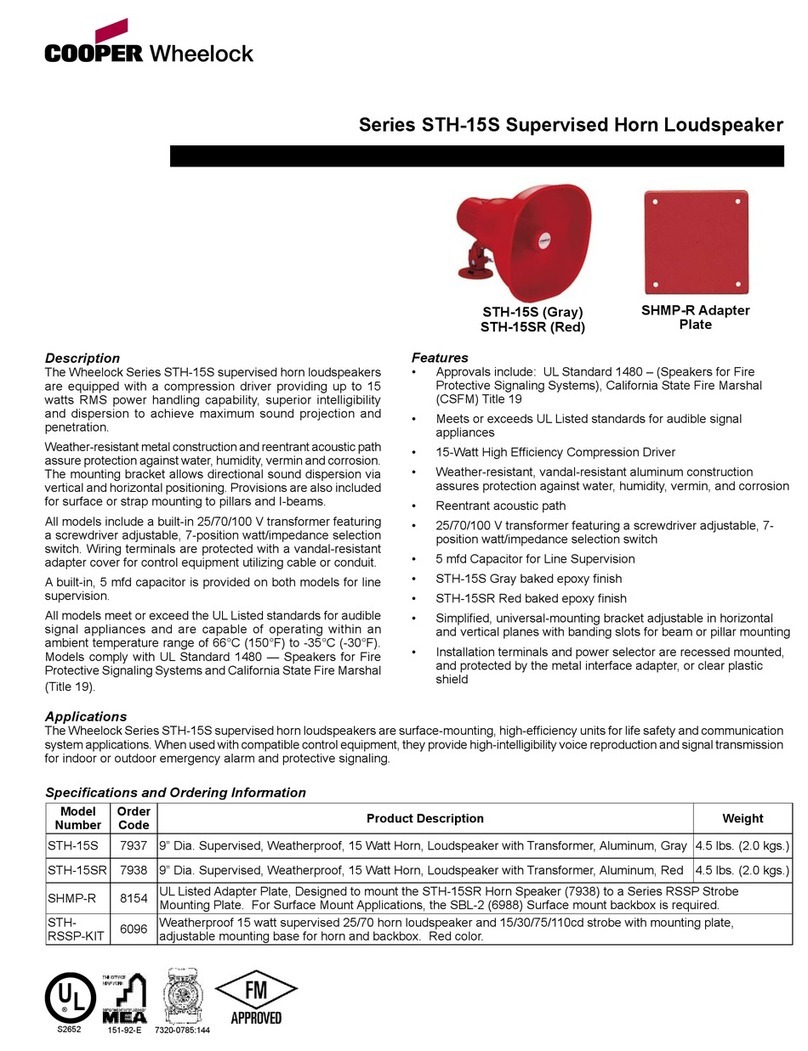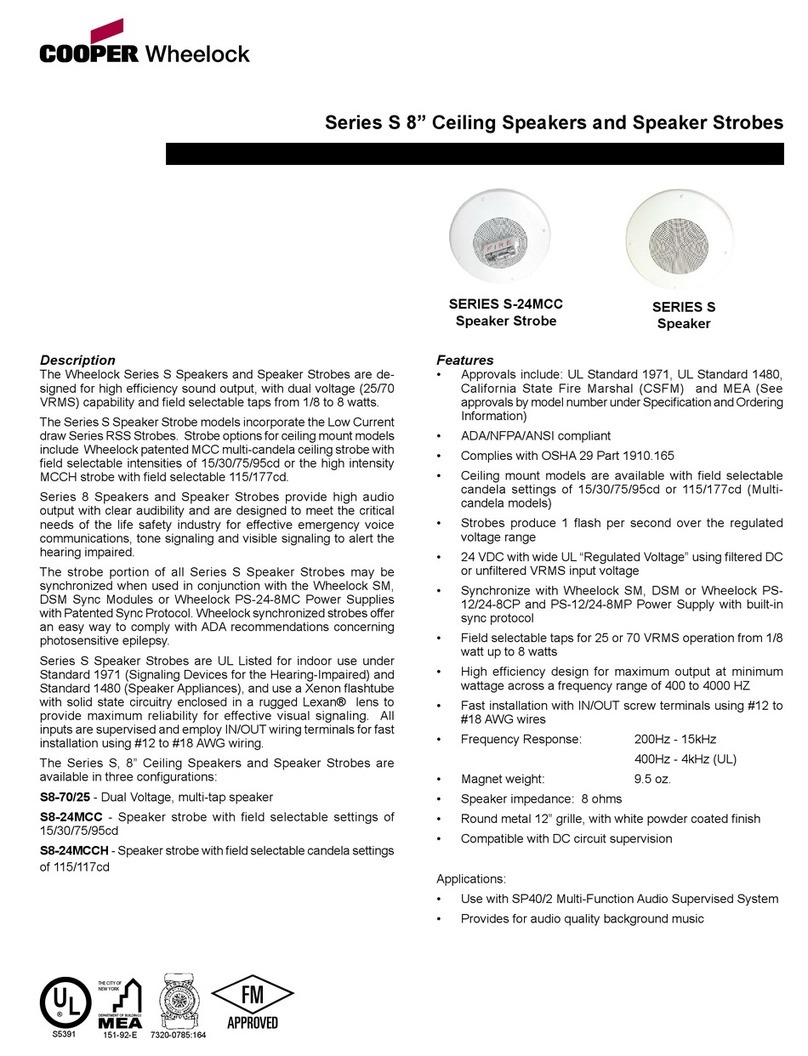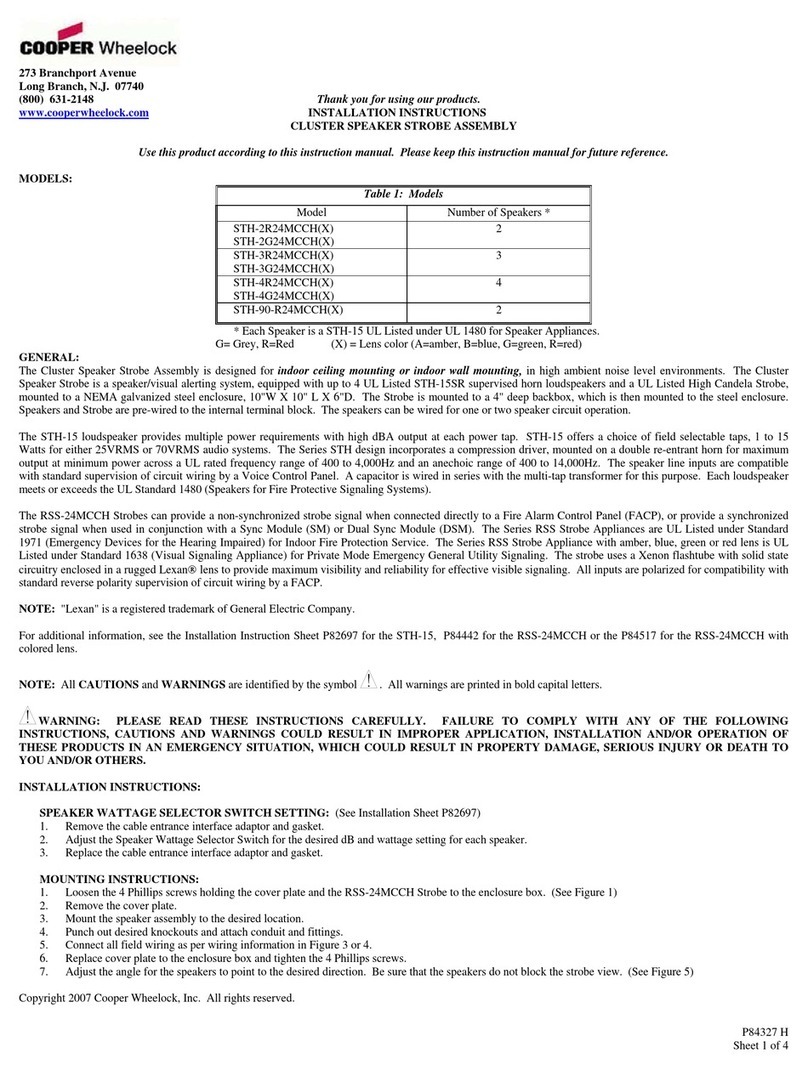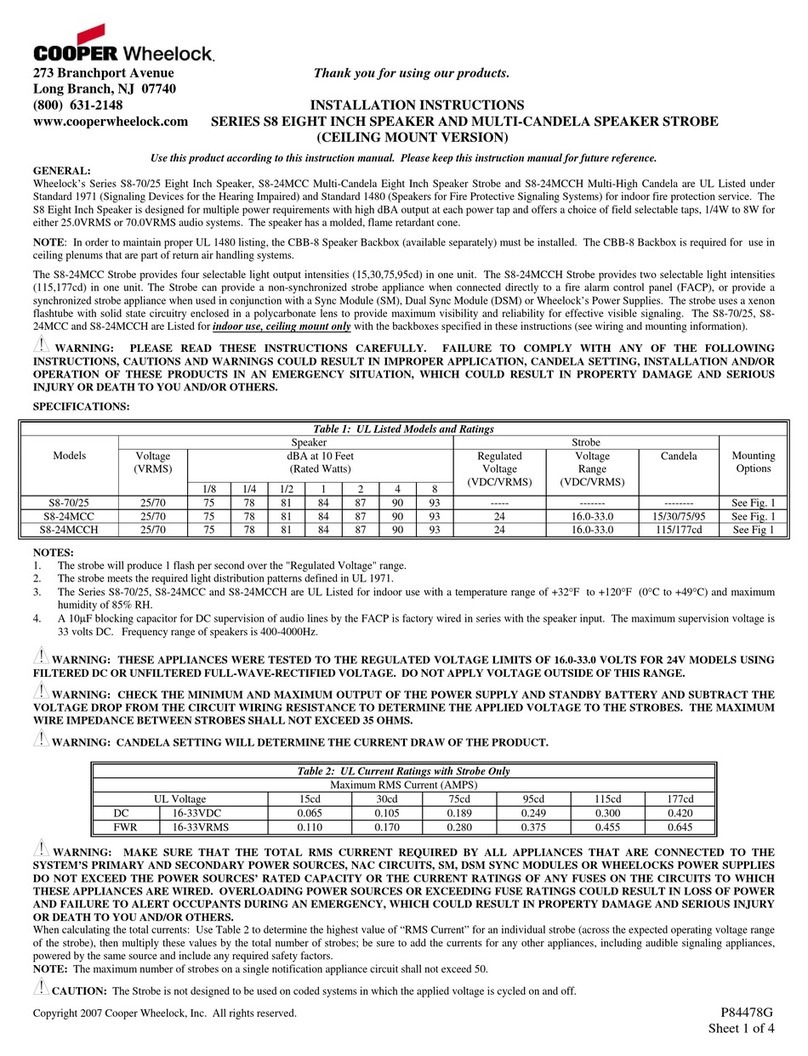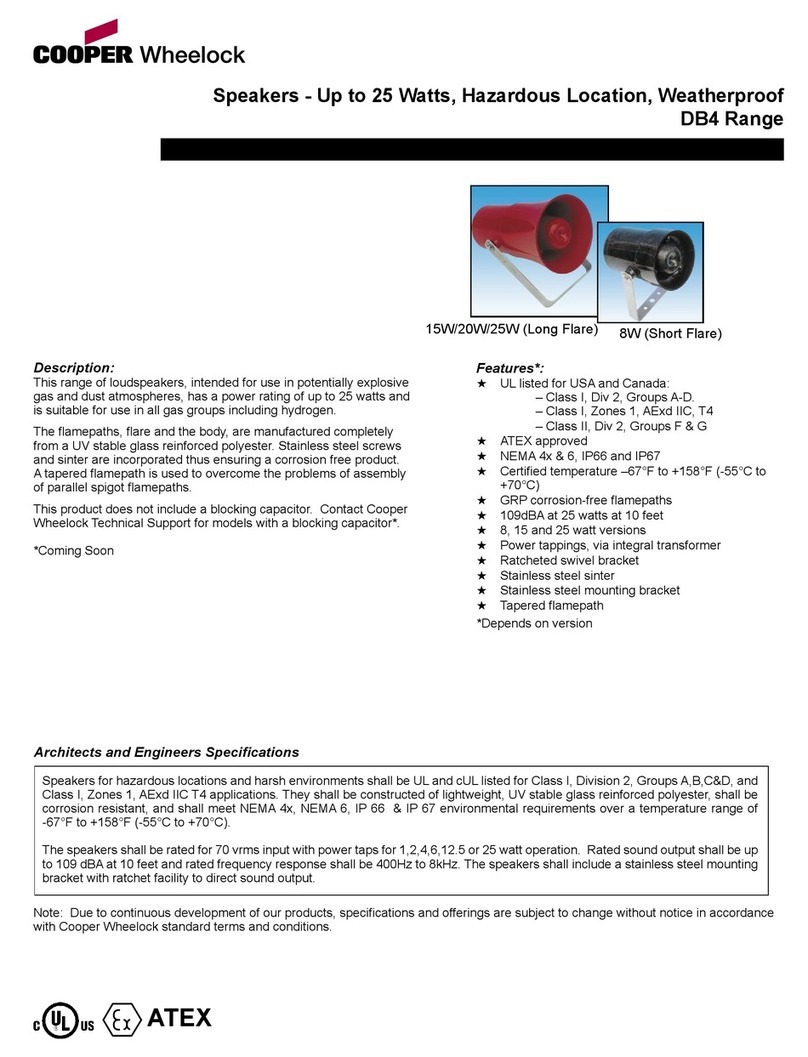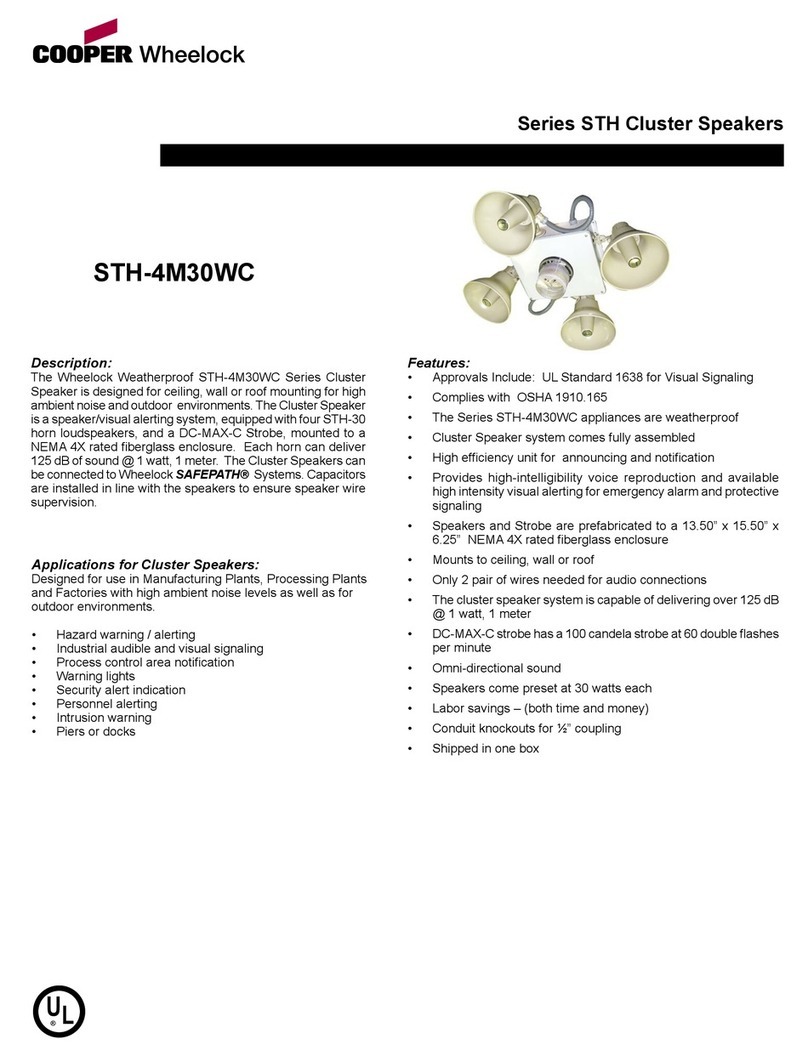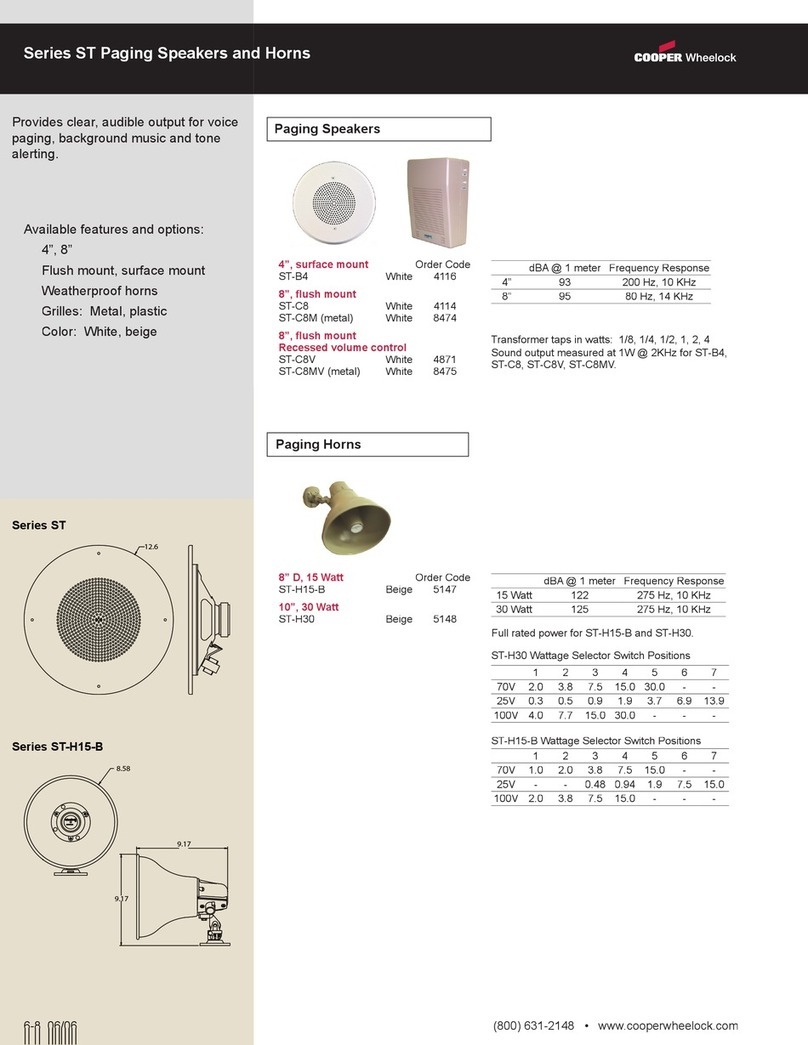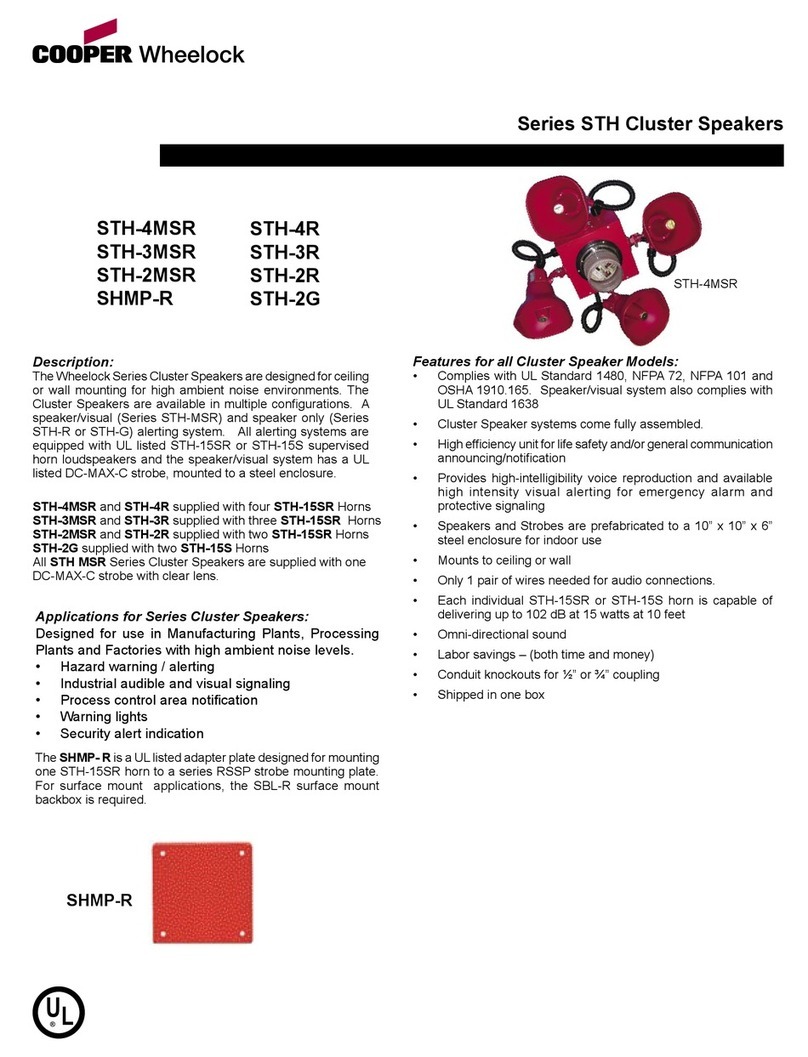
273 Branchport Ave.
Long Branch, N.J. 07740
(800) 631-2148
www.coopernotication.com
1
P85758B Copyright 2020 Cooper Wheelock Inc., dba Cooper Notication. All rights reserved.
Use this product according to this instruction manual. Please keep this instruction manual for future reference.
GENERAL
The Wheelock Eluxa ELSPC and ELSPSTC Series High-Fidelity Multi-Candela Speaker Strobes are designed for easy installation with
a pre-wire capable mounting plate. The Speaker Strobes with Amber lens are for Private Mode Emergency General Utility Signaling.
Amber lens strobe appliances also comply with the polar distribution requirements in the UL Standard 1971 for Indoor Fire Protection
Service and NFPA-72 for Mass Notication Systems.
ELSPC and ELSPSTC series High-Fidelity Multi-Candela Speakers Strobes are designed for multiple power requirements with high dBA
output at each power tap. ELSPC and ELSPSTC series Speakers are UL rated to meet the NFPA 72 requirement for 520Hz signals in
sleeping areas when used in conjunction with Wheelock Safepath products (see SP40S manual for more details)
The design incorporates a high eciency speaker for maximum output at minimum power across a frequency range of 300-8000Hz.
The strobes can provide non-synchronized strobe operation when connected directly to a Fire Alarm Control Panel (FACP), or provide
synchronized strobe operation when used in conjunction with a Dual Sync Module (DSM), or Wheelock’s Power Supplies.
The Wheelock Eluxa Series meets NFPA 2016 20 millisecond light pulse duration code requirements. In addition, the Wheelock Eluxa
and LED3 product lines have been UL/ULC listed as compatible with all Fire Alarm Control Panels (FACP) and accessories that have
been determined to be compatible with Wheelock model RSS Strobe based products including the RSS, CH, E, EH, ET,ST,HS,MT,S8,
SA, STH and Z Series. The maximum number of Eluxa devices per NAC is determined by dividing the maximum current rating of the
FACP NAC by the total current rating of one Eluxa device, with a maximum of 105 Eluxa (or LED3) devices per NAC. Refer to FACP
installation instructions for more detail. The Wheelock Eluxa Series and Exceder LED3 Series strobes may be installed in the same
notication zone and eld of view with any RSS Strobe based product.
WARNING: PLEASE READ THESE INSTRUCTIONS CAREFULLY BEFORE USING THIS PRODUCT. FAILURE TO COMPLY
WITH ANY OF THE FOLLOWING INSTRUCTIONS, CAUTIONS AND WARNINGS COULD RESULT IN IMPROPER APPLICA-
TION, CANDELA SETTING, INSTALLATION AND/OR OPERATION OF THESE PRODUCTS IN AN EMERGENCY SITUATION,
WHICH COULD RESULT IN PROPERTY DAMAGE AND SERIOUS INJURY OR DEATH TO YOU AND/OR OTHERS
CAUTION: Do not change factory applied nishes. “DO NOT PAINT”.
ATTENTION: Ne pas modiez les nitions appliquées en usine. “NE PAS PEINTURER”
Table 1: Specications
Agency ELSPSTC: UL1971, ULC-526-16. ELSPSTC-A: UL1638*, ULC-526-16
ELSPKC: UL1480, ULC-541-16
Environmental Indoor Use Only. +32ºF to +122ºF (0ºC to +50ºC) 93% RH
NAC Characteristics Max. line resistance: 35Ω
Input Voltage
Audio: 25Vrms or 70.7Vrms
Strobe: DC or FWR, 24V Regulated, 16 to 33V
Settings Strobe: 15, 30, 75, 110, 150, 177cd (eld selectable)
Speaker: 1/8W, 1/4W, 1/2W, 1W, 2W, 5W (eld selectable)
*UL1638 is an on axis rating where the following applies: eective candela rating per UL1971.
Table 2a: UL/ULC Listed Speaker Models and Ratings
Model Speaker
Voltage
Reverberant dBA at 10 Feet
Per UL 1480
Anechoic dBA at 10 Feet
Per ULC-S541-16
1/8 1/4 1/2 1 2 5 1/8 1/4 1/2 1 2 5
ELSP
25 75 79 82 85 87 --- 75 79 82 85 87 ---
70.7 75 79 82 85 --- 87 75 79 82 85 --- 87
ELSPST
25 75 79 82 85 87 --- 75 79 82 85 87 ---
70.7 75 79 82 85 --- 87 75 79 82 85 --- 87
Table 2b: ULC Directional Characteristics
-3dB +/- 80 degrees horizontal; +/- 80 degrees vertical
-6dB +/- 90 degrees horizontal; +/- 90 degrees vertical
Table 3: Strobe Current Draw (Amps) @ 24 volts
Strobe Candela Settings (cd)
Current 15cd 30cd 75cd 110cd 150cd 177cd
DC 0.022 0.030 0.060 0.086 0.125 0.185
FWR 0.036 0.050 0.092 0.142 0.196 0.274
NOTES:
1. Candela setting will determine the current draw of the product.
2. Strobes will produce 1 ash per second over the “Regulated Voltage” range.
3. Strobes are not designed to be used on coded systems in which the applied voltage is cycled on and o.
4. When calculating the total currents, use Table 3 to determine the highest value of “RMS Current” for an individual strobe (across
the expected operating voltage range of the strobe), then multiply these values by the total number of strobes; be sure to add
the currents for any other appliances, including audible signaling appliances, powered by the same source and include any
required safety factors.
5. Make sure that the total RMS current required by all appliances that are connected to the system’s primary and secondary
power sources, NAC Circuits , DSM Sync Modules or Cooper Wheelock Power Supplies do not exceed the power sources’ rated
capacity or the current ratings of any fuses on the circuits to which these appliances are wired. Refer to Sync Module instruction
sheets DSM (P83177) or Wheelock Power Supplies for additional information.
6. Check the minimum and maximum output of the power supply and standby battery and subtract the voltage drop from the circuit
wiring resistance to determine the applied voltage to the strobes.
7. Strobe appliance was tested to the regulated voltage limits of 16.0-33.0 Volts for 24 volt models using ltered DC or unltered
DC. Do not apply voltage outside of this range.
8. Strobe appliances are UL Listed as “Regulated”. They are intended to be used with Fire Alarm Control Panels (FACPs) whose
notication circuits are UL Listed as “Regulated”. Refer to the FACP instructions or the Wheelock Strobe Compatibility Data
Sheet (P85328) for special application and strobe synchronization compatibility.
WARNING: AMBER STROBES ARE NOT TO BE USED AS A VISUAL PUBLIC MODE ALARM NOTIFICATION APPLIANCE.
WARNING: OVERLOADING POWER SOURCES OR EXCEEDING FUSE RATINGS COULD RESULT IN LOSS OF POWER
AND FAILURE TO ALERT OCCUPANTS DURING AN EMERGENCY.
CAUTION: Always operate audio ampliers and speakers within their specied ratings. Excessive input may distort
sound quality and may damage audio equipment. Improper input voltage can damage speaker. If distortion is heard, check
for clipping of the audio signal voltage with an oscilloscope and reduce the amplier input level or gain level to eliminate
any clipping.
WARNING: WHEN INSTALLING STROBES IN AN OPEN OFFICE OR OTHER AREAS CONTAINING PARTITIONS OR OTHER
VIEWING OBSTRUCTIONS, SPECIAL ATTENTION SHOULD BE GIVEN TO THE LOCATION OF THE STROBES SO THAT
THEIR OPERATING EFFECT CAN BE SEEN BY ALL INTENDED VIEWERS, WITH THE INTESITY, NUMBER, AND ILLUMINA-
TION, REGARDLESS OF THE VIEWER’S ORIENTATION.
WARNING: A SMALL POSSIBILITY EXISTS THAT THE USE OF MULTIPLE STROBES WITHIN A PERSON’S FIELD OF
VIEW, UNDER CERTAIN CIRCUMSTANCES, MIGHT INDUCE A PHOTO-SENSITIVE RESPONSE IN PERSONS WITH EPILEPSY.
STROBE REFLECTIONS IN A GLASS OR MIRRORED SURFACE MIGHT ALSO INDUCE SUCH A RESPONSE. TO MINIMIZE
THIS POSSIBLE HAZARD, COOPER WHEELOCK STRONGLY RECOMMENDS THAT THE STROBES INSTALLED SHOULD
NOT PRESENT A COMPOSITE FLASH RATE IN THE FIELD OF VIEW WHICH EXCEEDS FIVE (5) HZ AT THE OPERAT-
ING VOLTAGE OF THE STROBES. COOPER WHEELOCK ALSO STRONGLY RECOMMENDS THAT THE INTENSITY AND
COMPOSITE FLASH RATE OF INSTALLED STROBES COMPLY WITH LEVELS ESTABLISHED BY APPLICABLE LAWS,
STANDARDS, REGULATIONS, CODES AND GUIDELINES.
NOTE: NFPA 72/ANSI 117.1 conforms to ADAAG Equivalent Facilitation Guidelines in using fewer, higher intensity strobes within the
same protected area.
INSTALLATION INSTRUCTIONS
WHEELOCK ELUXA HIGH FIDELITY SPEAKER
AND SPEAKER STROBES WITH PRE-WIRE/PRE-TEST
CEILING MOUNT (CLEAR AND AMBER LENS)
